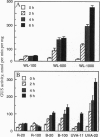Abstract
We have isolated, from the prokaryotic cyanobacterium Synechococcus sp. strain PCC 7942, a gene encoding a protein of 72 amino acids [designated high light inducible protein (HLIP)] with similarity to the extended family of eukaryotic chlorophyll a/b binding proteins (CABs). HLIP has a single membrane-spanning alpha-helix, whereas both the CABs and the related early light inducible proteins have three membrane-spanning helices. Hence, HLIP may represent an evolutionary progenitor of the eukaryotic members of the CAB extended family. We also show that the gene encoding HLIP is induced by high light and blue/UV-A radiation. The evolution, regulation, and potential function of HLIP are discussed.
Full text
PDF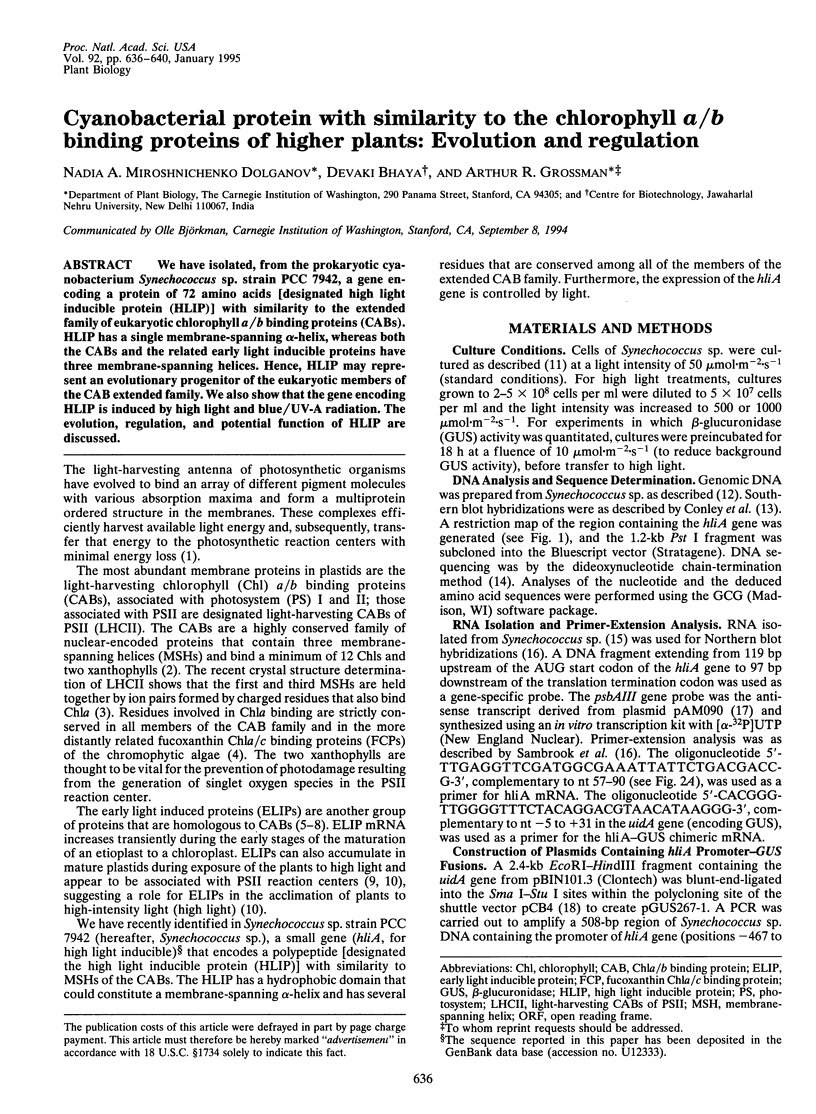
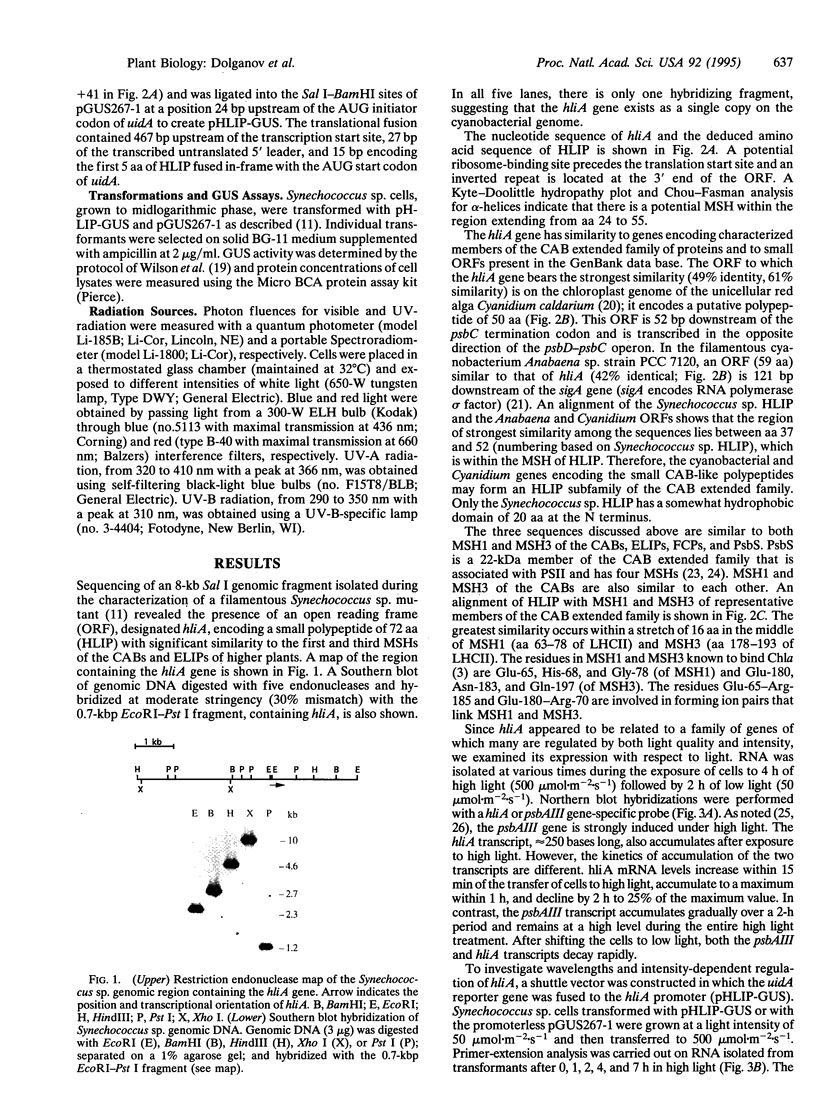
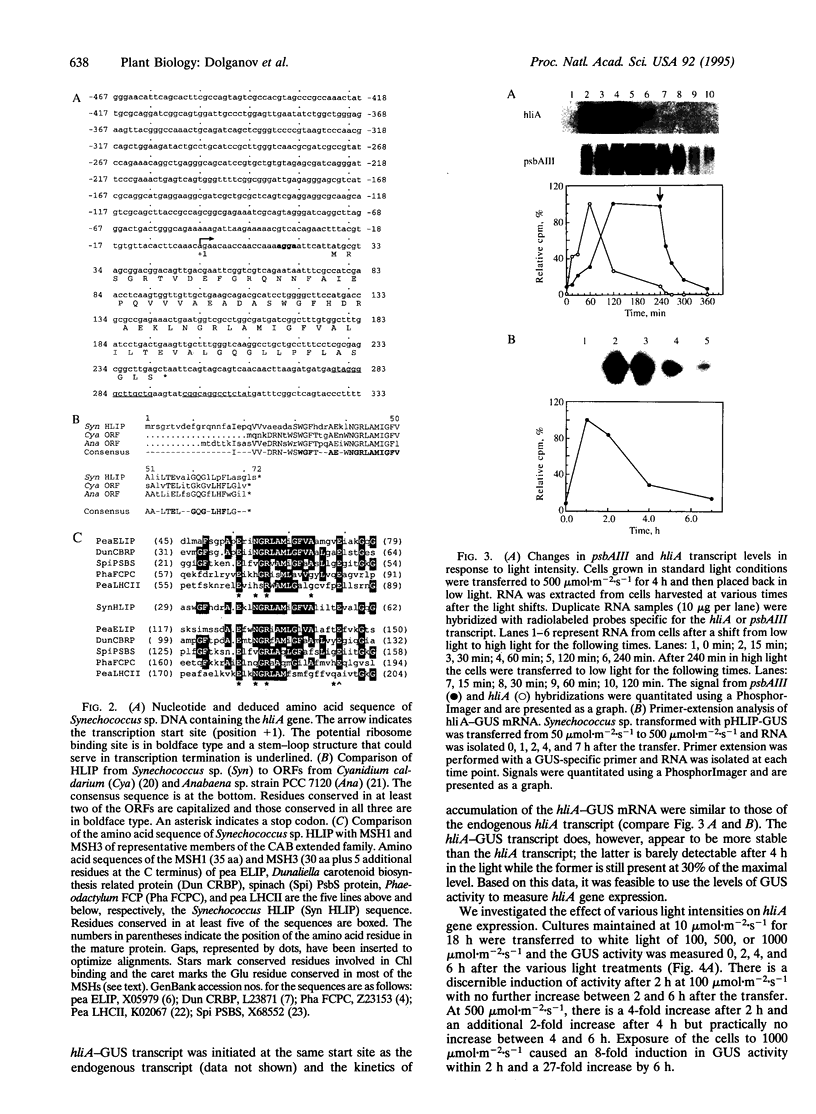

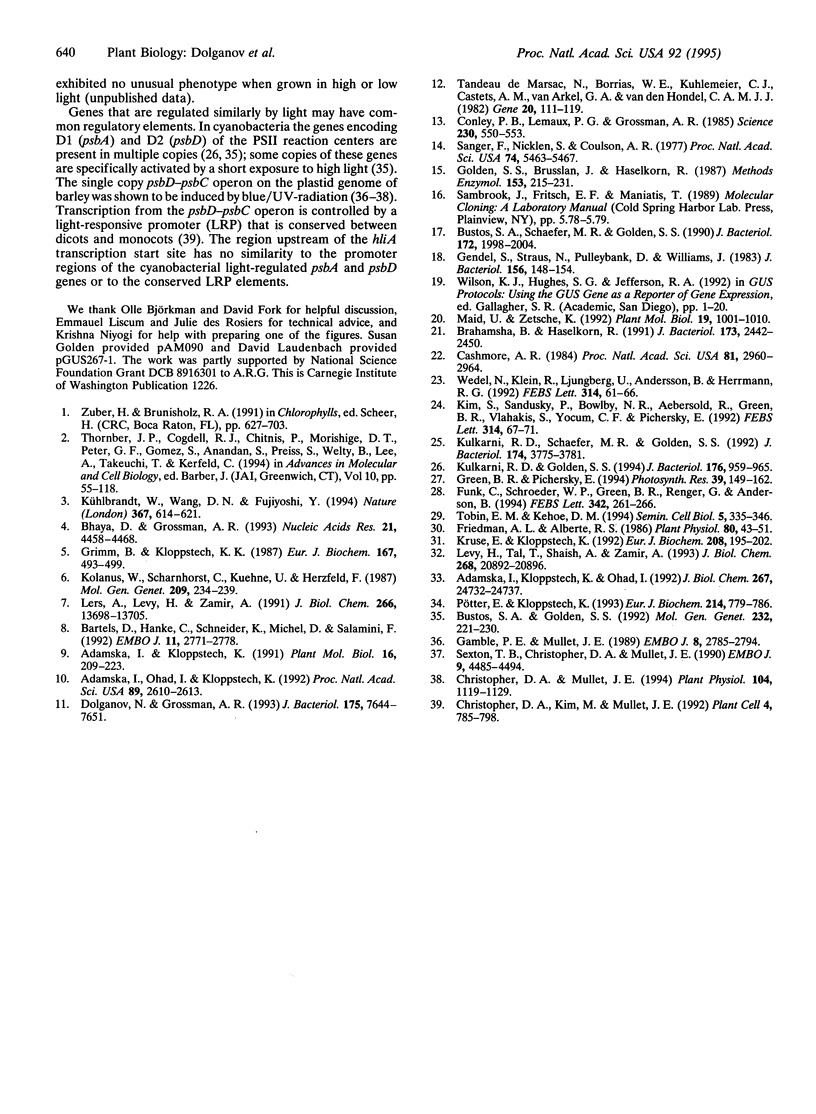
Images in this article
Selected References
These references are in PubMed. This may not be the complete list of references from this article.
- Adamska I., Kloppstech K. Evidence for an association of the early light-inducible protein (ELIP) of pea with photosystem II. Plant Mol Biol. 1991 Feb;16(2):209–223. doi: 10.1007/BF00020553. [DOI] [PubMed] [Google Scholar]
- Adamska I., Kloppstech K., Ohad I. UV light stress induces the synthesis of the early light-inducible protein and prevents its degradation. J Biol Chem. 1992 Dec 5;267(34):24732–24737. [PubMed] [Google Scholar]
- Adamska I., Ohad I., Kloppstech K. Synthesis of the early light-inducible protein is controlled by blue light and related to light stress. Proc Natl Acad Sci U S A. 1992 Apr 1;89(7):2610–2613. doi: 10.1073/pnas.89.7.2610. [DOI] [PMC free article] [PubMed] [Google Scholar]
- Bartels D., Hanke C., Schneider K., Michel D., Salamini F. A desiccation-related Elip-like gene from the resurrection plant Craterostigma plantagineum is regulated by light and ABA. EMBO J. 1992 Aug;11(8):2771–2778. doi: 10.1002/j.1460-2075.1992.tb05344.x. [DOI] [PMC free article] [PubMed] [Google Scholar]
- Bhaya D., Grossman A. R. Characterization of gene clusters encoding the fucoxanthin chlorophyll proteins of the diatom Phaeodactylum tricornutum. Nucleic Acids Res. 1993 Sep 25;21(19):4458–4466. doi: 10.1093/nar/21.19.4458. [DOI] [PMC free article] [PubMed] [Google Scholar]
- Brahamsha B., Haselkorn R. Isolation and characterization of the gene encoding the principal sigma factor of the vegetative cell RNA polymerase from the cyanobacterium Anabaena sp. strain PCC 7120. J Bacteriol. 1991 Apr;173(8):2442–2450. doi: 10.1128/jb.173.8.2442-2450.1991. [DOI] [PMC free article] [PubMed] [Google Scholar]
- Bustos S. A., Golden S. S. Light-regulated expression of the psbD gene family in Synechococcus sp. strain PCC 7942: evidence for the role of duplicated psbD genes in cyanobacteria. Mol Gen Genet. 1992 Mar;232(2):221–230. doi: 10.1007/BF00280000. [DOI] [PubMed] [Google Scholar]
- Bustos S. A., Schaefer M. R., Golden S. S. Different and rapid responses of four cyanobacterial psbA transcripts to changes in light intensity. J Bacteriol. 1990 Apr;172(4):1998–2004. doi: 10.1128/jb.172.4.1998-2004.1990. [DOI] [PMC free article] [PubMed] [Google Scholar]
- Cashmore A. R. Structure and expression of a pea nuclear gene encoding a chlorophyll a/b-binding polypeptide. Proc Natl Acad Sci U S A. 1984 May;81(10):2960–2964. doi: 10.1073/pnas.81.10.2960. [DOI] [PMC free article] [PubMed] [Google Scholar]
- Christopher D. A., Kim M., Mullet J. E. A novel light-regulated promoter is conserved in cereal and dicot chloroplasts. Plant Cell. 1992 Jul;4(7):785–798. doi: 10.1105/tpc.4.7.785. [DOI] [PMC free article] [PubMed] [Google Scholar]
- Christopher D. A., Mullet J. E. Separate photosensory pathways co-regulate blue light/ultraviolet-A-activated psbD-psbC transcription and light-induced D2 and CP43 degradation in barley (Hordeum vulgare) chloroplasts. Plant Physiol. 1994 Apr;104(4):1119–1129. doi: 10.1104/pp.104.4.1119. [DOI] [PMC free article] [PubMed] [Google Scholar]
- Conley P. B., Lemaux P. G., Grossman A. R. Cyanobacterial light-harvesting complex subunits encoded in two red light-induced transcripts. Science. 1985 Nov 1;230(4725):550–553. doi: 10.1126/science.3931221. [DOI] [PubMed] [Google Scholar]
- Dolganov N., Grossman A. R. Insertional inactivation of genes to isolate mutants of Synechococcus sp. strain PCC 7942: isolation of filamentous strains. J Bacteriol. 1993 Dec;175(23):7644–7651. doi: 10.1128/jb.175.23.7644-7651.1993. [DOI] [PMC free article] [PubMed] [Google Scholar]
- Friedman A. L., Alberte R. S. Biogenesis and light regulation of the major light harvesting chlorophyll-protein of diatoms. Plant Physiol. 1986 Jan;80(1):43–51. doi: 10.1104/pp.80.1.43. [DOI] [PMC free article] [PubMed] [Google Scholar]
- Funk C., Schröder W. P., Green B. R., Renger G., Andersson B. The intrinsic 22 kDa protein is a chlorophyll-binding subunit of photosystem II. FEBS Lett. 1994 Apr 11;342(3):261–266. doi: 10.1016/0014-5793(94)80513-x. [DOI] [PubMed] [Google Scholar]
- Gamble P. E., Mullet J. E. Blue light regulates the accumulation of two psbD-psbC transcripts in barley chloroplasts. EMBO J. 1989 Oct;8(10):2785–2794. doi: 10.1002/j.1460-2075.1989.tb08424.x. [DOI] [PMC free article] [PubMed] [Google Scholar]
- Gendel S., Straus N., Pulleyblank D., Williams J. Shuttle cloning vectors for the cyanobacterium Anacystis nidulans. J Bacteriol. 1983 Oct;156(1):148–154. doi: 10.1128/jb.156.1.148-154.1983. [DOI] [PMC free article] [PubMed] [Google Scholar]
- Golden S. S., Brusslan J., Haselkorn R. Genetic engineering of the cyanobacterial chromosome. Methods Enzymol. 1987;153:215–231. doi: 10.1016/0076-6879(87)53055-5. [DOI] [PubMed] [Google Scholar]
- Grimm B., Kloppstech K. The early light-inducible proteins of barley. Characterization of two families of 2-h-specific nuclear-coded chloroplast proteins. Eur J Biochem. 1987 Sep 15;167(3):493–499. doi: 10.1111/j.1432-1033.1987.tb13364.x. [DOI] [PubMed] [Google Scholar]
- Kim S., Sandusky P., Bowlby N. R., Aebersold R., Green B. R., Vlahakis S., Yocum C. F., Pichersky E. Characterization of a spinach psbS cDNA encoding the 22 kDa protein of photosystem II. FEBS Lett. 1992 Dec 7;314(1):67–71. doi: 10.1016/0014-5793(92)81463-v. [DOI] [PubMed] [Google Scholar]
- Kolanus W, Scharnhorst C, Kühne U, Herzfeld F. The structure and light-dependent transient expression of a nuclear-encoded chloroplast protein gene from pea (Pisum sativum L.). Mol Gen Genet. 1987 Sep;209(2):234–239. doi: 10.1007/BF00329648. [DOI] [PubMed] [Google Scholar]
- Kruse E., Kloppstech K. Integration of early light-inducible proteins into isolated thylakoid membranes. Eur J Biochem. 1992 Aug 15;208(1):195–202. doi: 10.1111/j.1432-1033.1992.tb17174.x. [DOI] [PubMed] [Google Scholar]
- Kulkarni R. D., Golden S. S. Adaptation to high light intensity in Synechococcus sp. strain PCC 7942: regulation of three psbA genes and two forms of the D1 protein. J Bacteriol. 1994 Feb;176(4):959–965. doi: 10.1128/jb.176.4.959-965.1994. [DOI] [PMC free article] [PubMed] [Google Scholar]
- Kulkarni R. D., Schaefer M. R., Golden S. S. Transcriptional and posttranscriptional components of psbA response to high light intensity in Synechococcus sp. strain PCC 7942. J Bacteriol. 1992 Jun;174(11):3775–3781. doi: 10.1128/jb.174.11.3775-3781.1992. [DOI] [PMC free article] [PubMed] [Google Scholar]
- Kühlbrandt W., Wang D. N., Fujiyoshi Y. Atomic model of plant light-harvesting complex by electron crystallography. Nature. 1994 Feb 17;367(6464):614–621. doi: 10.1038/367614a0. [DOI] [PubMed] [Google Scholar]
- Lers A., Levy H., Zamir A. Co-regulation of a gene homologous to early light-induced genes in higher plants and beta-carotene biosynthesis in the alga Dunaliella bardawil. J Biol Chem. 1991 Jul 25;266(21):13698–13705. [PubMed] [Google Scholar]
- Levy H., Tal T., Shaish A., Zamir A. Cbr, an algal homolog of plant early light-induced proteins, is a putative zeaxanthin binding protein. J Biol Chem. 1993 Oct 5;268(28):20892–20896. [PubMed] [Google Scholar]
- Maid U., Zetsche K. A 16 kb small single-copy region separates the plastid DNA inverted repeat of the unicellular red alga Cyanidium caldarium: physical mapping of the IR-flanking regions and nucleotide sequences of the psbD-psbC, rps16, 5S rRNA and rpl21 genes. Plant Mol Biol. 1992 Sep;19(6):1001–1010. doi: 10.1007/BF00040531. [DOI] [PubMed] [Google Scholar]
- Pötter E., Kloppstech K. Effects of light stress on the expression of early light-inducible proteins in barley. Eur J Biochem. 1993 Jun 15;214(3):779–786. doi: 10.1111/j.1432-1033.1993.tb17980.x. [DOI] [PubMed] [Google Scholar]
- Sanger F., Nicklen S., Coulson A. R. DNA sequencing with chain-terminating inhibitors. Proc Natl Acad Sci U S A. 1977 Dec;74(12):5463–5467. doi: 10.1073/pnas.74.12.5463. [DOI] [PMC free article] [PubMed] [Google Scholar]
- Sexton T. B., Christopher D. A., Mullet J. E. Light-induced switch in barley psbD-psbC promoter utilization: a novel mechanism regulating chloroplast gene expression. EMBO J. 1990 Dec;9(13):4485–4494. doi: 10.1002/j.1460-2075.1990.tb07899.x. [DOI] [PMC free article] [PubMed] [Google Scholar]
- Tandeau de Marsac N., Borrias W. E., Kuhlemeier C. J., Castets A. M., van Arkel G. A., van den Hondel C. A. A new approach for molecular cloning in cyanobacteria: cloning of an Anacystis nidulans met gene using a Tn901-induced mutant. Gene. 1982 Nov;20(1):111–119. doi: 10.1016/0378-1119(82)90092-0. [DOI] [PubMed] [Google Scholar]
- Tobin E. M., Kehoe D. M. Phytochrome regulated gene expression. Semin Cell Biol. 1994 Oct;5(5):335–346. doi: 10.1006/scel.1994.1040. [DOI] [PubMed] [Google Scholar]
- Wedel N., Klein R., Ljungberg U., Andersson B., Herrmann R. G. The single-copy gene psbS codes for a phylogenetically intriguing 22 kDa polypeptide of photosystem II. FEBS Lett. 1992 Dec 7;314(1):61–66. doi: 10.1016/0014-5793(92)81462-u. [DOI] [PubMed] [Google Scholar]





